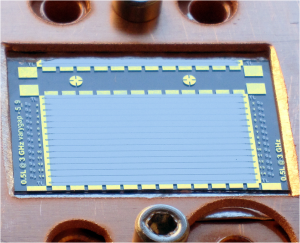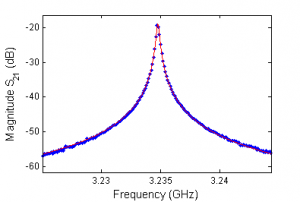Development of Superconducting Resonators for Quantum Coupling to Trapped Ions

Figure 1: Resonators fabricated from niobium sputtered on sapphire. Each resonator is 20 mm in length and 11 um in width and has gold contact pads at either end for contact with the testing apparatus.
Over the last decade, quantum information experiments with trapped ions have demonstrated essential steps towards quantum computing and quantum simulation [1]. Large fields are required to achieve strong coupling to the ions via dipolar interactions. To accomplish this coupling, we are integrating transmission line microresonators into the 2D trap structures already implemented at the Center for Ultracold Atoms at MIT [2] [3]. The resonators are superconducting niobium to minimize-loss and maximize-quality factors [4] [5]. Using the large fields locally generated from the accumulation of microwave photons in the resonator, we hope to demonstrate interaction with the trapped ions first by heating them, and eventually to control the rotational states of the ions by coherently coupling to them.

Figure 2: A Lorentzian fit to resonator transmission (S21) power measurements. The quality factor associated with the fit is 12,000.
We fabricated the resonators as two-dimensional coplanar waveguides in niobium on R-plane sapphire using optical lithography. We deposited the niobium layers on the sapphire with an in-house DC magnetron sputtering system. The back side was thinly coated to create a ground plane, after which the front is coated to a thickness of approximately 400 nm. Tests showed that the niobium achieved superconductivity at the expected temperature of 9.2 K. Once we completed the material stack, we patterned the front niobium layer in NR9-3000P resist using optical lithography, developed it, and then reactive-ion etched it with CF4 and O2 to transfer the pattern into the niobium.
Current results from our fabricated resonators show first-resonance quality factors of at least 104 at 3.23 GHz and device temperatures of 3-4 K. In the near future we expect to see one or two orders of magnitude of improvement as we move from our probe-station testing apparatus to a full-immersion system to better isolate the devices and control temperature. In addition, we have prototyped designs to integrate resonators into existing superconducting traps.
References
- A. André, D. DeMille, J. M. Doyle, et al. “A coherent all-electrical interface between polar molecules and mesoscopic superconducting resonators,” Nature Physics, vol. 2(9), pp. 636-642, 2006. [↩]
- J. Labaziewcz, Y. Ge, P. Antohi, D. Leibrandt, K. Brown, and I. L. Chuang, “Suppression of Heating Rates in Cryogenic Surface-Electrode Ion traps,” Phys. Rev. Lett. 100: 130001, 2008. [↩]
- D. Stick, W. Hensinger, S. Olmschenk, et al. “Ion trap in a semiconductor chip,” Nature Physics, vol. 2(1), pp. 36-39, 2005. [↩]
- M. Göppl, A. Fragner, M. Baur, R. Bianchetti, S. Filipp, J. Fink, et al. “Coplanar waveguide resonators for circuit quantum electrodynamics,” Journal of Applied Physics, vol. 104(11), pp. 3904, 2008. [↩]
- J. Gao, “The physics of superconducting microwave resonators,” PhD thesis, California Institute of Technology, Pasadena, 2008. [↩]